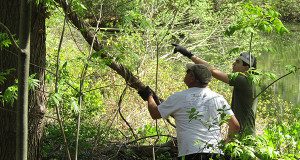[ccfic caption-text format="plaintext"]
By Amelia Tarallo
Hometown Weekly Staff
“It’s like a Gordian knot,” observed one of the volunteers who came to clean up Haslam Pond. The branch of a tree in front of her had become completely entangled with bittersweet, a-fast growing invasive species. It had grown like a boa constrictor, strangling its prey, and now there was no way to tell where the bittersweet ended and where the tree began.
A Gordian Knot is a metaphor used to describe an unsolvable problem, and may be the perfect way to look at the entirety of Haslam Pond’s problem. For years, it has been left fairly unattended and unkempt, as a result becoming the perfect place for invasive species to take root and attack the area’s trees. The spillway of the pond has been damaged due to years of weathering and now lets out an overflow of water.
But Saturday, May 18, marked a hopeful change for the pond. People of all ages, from elementary school-aged kids to teenagers and parents, took branch clippers, shovels, and gloves and made it their goal to leave Haslam Pond in a better state than when they had started. After a brief overview of what they would doing, volunteers got to work pulling up bittersweet, cutting away dead branches, and picking up any trash they found along the way. In one place, the vines of bittersweet had tangled together to make a collection of vines so strong that one volunteer, who tried to take it down by pulling it, found himself swinging on it instead. Other volunteers banded together to take out entire dead trees, as if they were amateur lumberjacks.
The section including the pond and the area around it is considered town conservation land, donated by Charlotte and Emerson Haslam in 1964. Today, the area is used for ice skating, kayaking, and wildlife watching. The giant woodpecker, the green heron, otters, three or four species of turtle, muskrats, geese, and ducks all make their home at Haslam Pond. “It really is a community asset, and we’re trying not to lose it. We’re trying to keep it for future generations,” said Alexis Hamdan.
Hamdan lives near the spillway area of the pond and helped organize the clean-up. In her 15 years of living here, Hamdan has witnessed the decline of the pond. “The Charles River Watershed Association are saying that because of climate change, they are seeing changes in the quality of the water, so that’s the next step we’re going to focus on so that the water doesn’t get overtaken.” Even with all the work the one clean-up accomplished, the pond still has a long way to go before it is back to normal. “This is step one.”
Much of the clean-up focused on clearing the invasive species, mostly bittersweet, but also including Japanese knotweed, a form of bamboo that endangers the lives of local vegetation. “With any invasive, you want to pull it out by the root so it doesn’t continue to grow,” said Lisa Kumpf, an aquatic scientist from the Charles River Watershed Association who came to help clean up. “The thing with invasive species and why we try to target them and why they are very good at what they do is that they are very hardy plants.” Survival is not an issue for these invasives in the area around Haslam Pond; these species are thriving.
But the trees around Haslam may struggle if bittersweet and other invasive species are allowed to flourish. The trees around the pond (and everywhere) are good at filtering out excessive nutrients; nutrient overpresence is a problem with many water sources now. Additionally, the trees hold in water and prevent flooding. If these trees die, it’s not just the ecosystem around Haslam Pond that is going to have a problem - it’s the people of Westwood.
Saturday’s clean-up showed that the Westwood community truly does care about its natural resources. “The fact that anyone came out on this beautiful Saturday morning, the day after prom, is really inspiring,” said Hamdan. In the future, Hamdan hopes that more people will come out to help clean up Haslam Pond. “I think when they start seeing the results of what we’re doing, more people will be inspired to come out and help.”

The spillway at Haslam Pond. DPW has promised to fix the spillway, which is critical to maintain water levels and ecosystems.
By the end of the clean-up, there were piles and piles of branches and debris that were ready to be trucked off and put through a chipper. “Even though it's pretty far gone, we can take back control of this.” The area that volunteers had focused on was almost completely unrecognizable by the end of the day, and it was clear that there was hope for the indigenous species of the area.
In the middle of the forest was one lone holly plant, now receiving the sunlight and water it will need to thrive - all because a few volunteers spent their Saturday morning cleaning Haslam Pond.






















